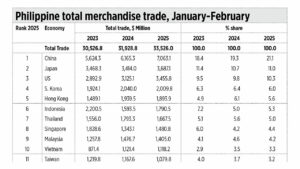PHL net external liability position narrows at end-Dec.

THE PHILIPPINES’ international investment position (IIP) stood at a net external liability of $65.5 billion at the end of December, the central bank said.
Bangko Sentral ng Pilipinas (BSP) data showed the net external liability fell by 10.2% at end-December 2024 from the $72.9-billion net liability at end-September 2024.
Year on year, the net external liability position widened by 29% from $50.7 billion in the same period a year ago.
The IIP is an indicator of the value and composition of a country’s financial assets and liabilities. It gauges an economy’s external exposure.
“This development was driven by a 3.4% contraction in the country’s external financial liabilities, which outpaced the 1.4% decline in external financial assets,” the BSP said in a statement.
BSP data showed total outstanding external financial assets fell by 1.4% to $252.7 billion as of end-December from $256.4 billion as of the end-third quarter.
Year on year, it rose by 4.2% from $242.4 billion.
“The country’s total stock of external financial assets contracted mainly on account of the decline in the country’s reserve assets, which stood at $106.3 billion as of end-December 2024 (or a decrease of 5.7% from $112.7 billion as of end-September 2024),” the BSP said.
The central bank also noted that the residents’ net direct investments in debt instruments slid by 2.7% quarter on quarter to $41.8 billion.
Almost half or 43.9% of the external financial assets are held by the BSP, valued at $110.8 billion as of end-December 2024. This was 5.9% lower than the BSP’s $117.8-billion asset holdings at end-September 2024.
“The said development stemmed mainly from the 5.7% decline in the reserve assets, which constitute the majority of the BSP’s external financial holdings,” the BSP said.
Other sectors accounted for 40.9% of the total or $103.4 billion during the same period while banks kept $38.5 billion or 15.2% share.
Meanwhile, total outstanding external financial liabilities dropped by 3.4% to $318.2 billion as of end-December from $329.3 billion at the end of September.
Year on year, it rose by 8.5% from $293.1 billion.
“The country’s total stock of external financial liabilities as of end-December 2024 decreased, primarily due to an 8.2% decline in foreign portfolio investment (FPI) (to $96.3 billion from $104.9 billion) and a 2% decline in foreign direct investment (FDI) (to $129.3 billion from $132 billion),” the BSP said.
The drop in FPI was attributed to the 14.1% decline in nonresidents’ outstanding investments in equity securities of local corporations.
“This mirrored the drop in the Philippine Stock Exchange index (PSEi), which experienced significant declines amid growing concerns over the policies of US President-elect Donald Trump, particularly the proposed import tariff hike that could lead to higher interest rates,” the BSP said.
The PSEi closed at 6,528.79 at the end of December 2024 from 7,272.65 at the end of September 2024.
The BSP also noted outstanding investment in debt securities by nonresidents fell by 3.9% to $58.7 billion as of end-December.
“This decrease was driven by foreign investors’ net selling of their holdings in debt securities issued by the National Government (NG) to residents in the secondary market as well as NG’s and other sectors’ net repayments of debt securities held by nonresidents,” it said.
The BSP also said that net FDI slipped by 2% to $129.3 billion “due to downward valuation adjustments in nonresidents’ net investments in equity capital.”
According to the BSP, other sectors had the biggest share or 58% of the total external financial liabilities, equivalent to $184.6 billion at end-December.
The rest were held by the NG with external financial liabilities of $87.6 billion and banks with $42.2 billion.
The BSP held 1.2% of all external financial liabilities at $3.7 billion, which were mostly in the form of special drawing rights.
Rizal Commercial Banking Corp. Chief Economist Michael L. Ricafort said the narrower net external liability position is partly due to the seasonal increase in debt payments, consistent with a rise in government expenditures and wider budget deficit.
Mr. Ricafort also attributed this to relatively higher interest rates and a weaker peso-dollar exchange rate. — Aubrey Rose A. Inosante




